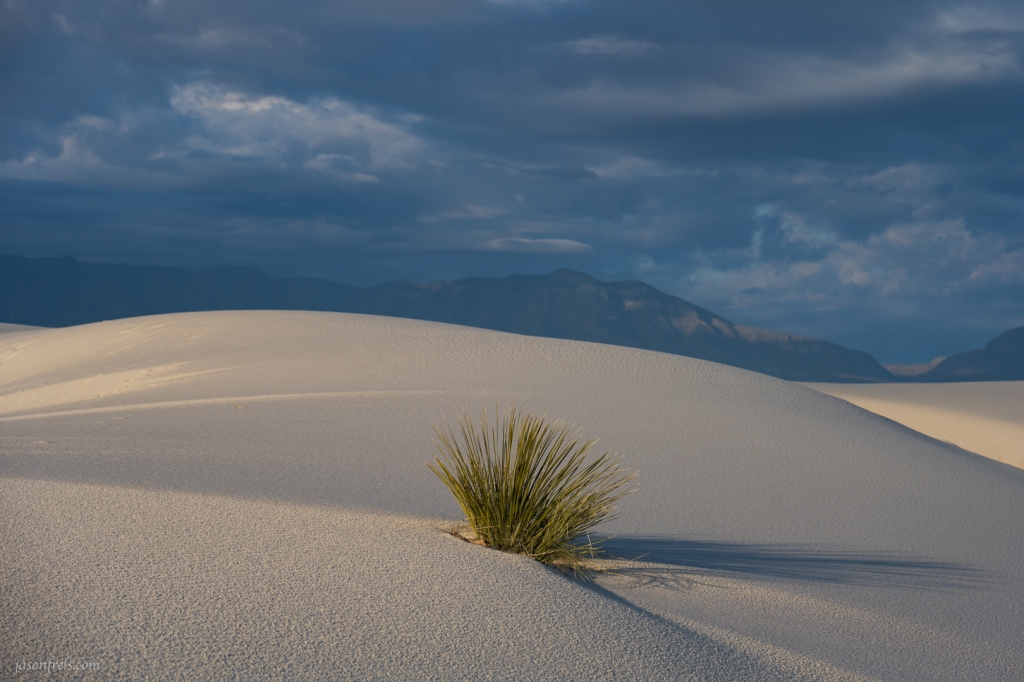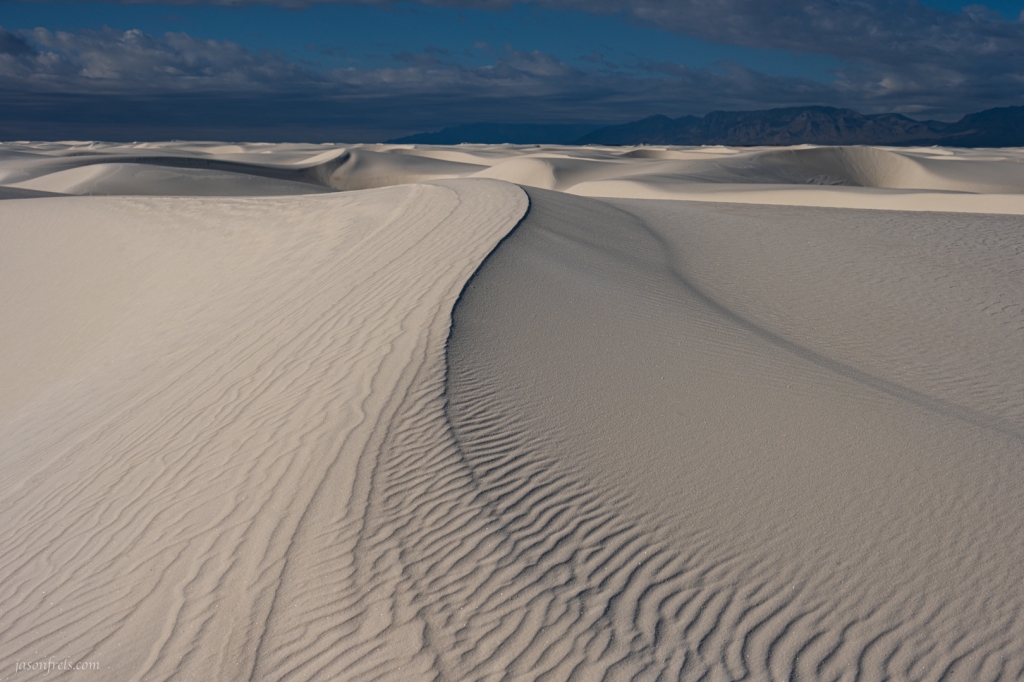I decided to arrange a spring hiking trip to some desert locations for mid-March. I targeted this time because it probably wouldn’t be brutally cold in early spring nor would it yet be very hot. I also wanted there to be a chance of wildflower blooms in the deserts. My trip started with White Sands National Park near Alamogordo, New Mexico. This was a national park that I hadn’t yet visited and always wanted to see and attempt photographing the dunes. I will not be discussing my stop at Great Sand Dunes National Park a couple of years ago but suffice it to say that I wore sandals on the dunes during this trip.
I arrived at the park on a Monday afternoon which was unfortunately quite cloudy. There aren’t many defined hiking trails in the park and you generally just drive down the main road, find a place to stop, and go wandering out into the dunes. One popular activity is saucer sledding down the dunes and you can rent a sled in the park store. But I wasn’t there for sledding so I wandered around the dunes with my camera generally enjoying the cool sand on my sandal-clad feet. As it was cloudy on this afternoon, I wasn’t very pleased with my photos. But the next day I was at the park gate when it opened at 7:00AM and hoping for some dawn light.

The day started off with heavy clouds on the eastern horizon, but fortunately these clouds would thin out as the day began. I began wandering some dunes to the east of the park road where there seemed to be more plant life in the dunes. Photographically, the dunes are mostly negative space and your options are to find a subject and use the sand as a back-drop or you can focus on contours of the dunes to make an interesting photo. I tried a little of both on this outing.
In the image below I have a desert plant with the dunes as a background. I think that the windblown sand is in the process of covering the plant. To make this photo I selected a plant with undisturbed sand around it, and shot from a height such that the plant would be visually contained within the dune background. I shot with a longer focal length, 115mm in this case, to make the mountains appear larger in the distance and to cut out some of the surrounding plants. And shooting at a right-angle to the sun light provided me with side-light for some definition in the sand from the shadows. The result is a plant and mountains that are visually separated by the rolling dunes. I would like to have a little light on the distant mountains.

After this I moved over to the dunes west of the main road as these dunes appeared to be less interrupted by areas of plants and I was looking to make some sandy contour photos in the morning light. To find undisturbed sand, I did have to walk a long way from the parking area out past the areas where people have played in the sand. I eventually came to an area where the only footprints were being made by me (and the occasional bird). It is also nice to be able to retrace your steps when you want to return to the car as the dunes all start to look alike out here.
On the tops of some of the dunes, the wind forms a ridge creating curvy lines across the landscape. During noon-time sunlight from above, these ripples and ridges don’t stand out so much, but if you shoot early or late in the day the side-light adds contrast to help give form to the lines and depth to the dunes. So I wandered around finding lines that ran perpendicular to the sunlight and that would have clean dunes in the background. There were a lot of beautiful patterns to choose from in this undisturbed expanse of dunes. I tried to make the lines lead somewhere into the distance instead of just letting them run out of frame to one side. In the image below, the S-shaped ridge of sand leads you to the rolling dunes and mountains beyond.

I found that one of the main techniques in taking these shots is positioning the height of the camera to be high enough to include the distant dunes and mountains in the background but low enough to hide any plants behind the dunes. In the photo below, shot at 88mm, you can see the curvy lines of the dune leading toward the distant mountains. If you look closely, you can see some bird tracks running across the scene. Between the dunes, there are areas of desert plants that are not be seen in this photo as I found them to be too distracting, so I crouched down until I could no longer see them.

Another idea I tried was getting the camera so low it was almost on the sand. I was trying to exaggerate the ripples of the sand in the foreground with the curvy line of the ridge in the distance. It was difficult to decide what should be in sharp focus in the image below, so I took multiple shots. I decided that I liked the foreground sand ripples to be mostly in focus. Focus-stacking would have been an option if I was carrying a tripod, but I was walking with just a camera and lens. Below is my close-up of windblown sand-ripples giving some definition to the gypsum white sand.

Another issue is deciding how much sky to put in the image. You don’t want a thin sliver of sky at the top as the image feels too constrained, but you do want the landscape to be the star of the image. I may have not quite left enough sky in the above image. What do you think?
Walking around the clean sand dunes on this morning I felt like I had a photograph every where I looked and indeed I took hundreds of photos. But there were some scenes that I thought stood out from the others and made for interesting photos. I hope you thought so too. Thanks for reading.

Oh man! You were near my neck of the woods!! As always, you photos are just awesome. I admit as close as I am to White Sands, I’ve never been there myself, I do however on occasion have to go onto the test facility for NASA business. The mountains in the background looks just beautiful because of the angles you took of the sand. Well that’s how I see it.
LikeLiked by 2 people
You could go out there, rent a sled, and go flying down the dunes.
LikeLiked by 1 person
Ironically, you don’t need footwear to walk the dunes of White Sands. I was there once, during the month of June, and walked the dunes barefoot. This was at noon, when the sand was the hottest. The white reflective color, and the gypsum of the sand somehow keeps it from warming up too much, the way quartz-based sand warms up.
All beautiful shots. I think the sky is just right in your last shot, as the small amount of sky helps to emphasize the height of the dune.
LikeLiked by 2 people
Yeah, I discovered that this sand is much softer and cooler but I wasn’t taking chances.
Thanks, I wasn’t all that happy with the skies I got at this park at sunset and sunrise there were just thick cloud banks on the horizon.
LikeLiked by 1 person
It can be hard to find a sky that will cooperate at the times of sunrise and sunset.
LikeLiked by 1 person
I wish the same could be said about the sand at the beach during the hottest part of the day!
LikeLiked by 1 person
The gypsum sand at White Sands is fairly rare. I don’t think you’ll find any gypsum sand beaches.
LikeLiked by 2 people
Well, that’s why I will just keep walking along the water’s edge over the hottest part of the day. The wet sand stays cool 😎
LikeLiked by 2 people
Good idea, except that’s where the sand crabs like to hang out, with their little pincers waiting to grab your toes.
LikeLiked by 1 person
Pffft! The sand crabs stay away from me.
LikeLiked by 1 person
Maybe you’ve just been lucky so far.
LikeLiked by 1 person
And it will stay that way. Like my luck with the seagulls. 😉
LikeLiked by 2 people
I didn’t see any crabs or seagulls at White Sands.
LikeLiked by 2 people
What a “surprise”, smartie! A seagull would look nice flying over the dunes.
LikeLiked by 1 person
A lost seagull.
LikeLiked by 1 person
Yes, its GPS must have stopped working
LikeLiked by 1 person
Uh-huh. Better keep your toes and your eyes crossed.
LikeLiked by 2 people
Exquisite images, Jason. There is something quite ethereal about sand dunes. Well done, sir.
LikeLiked by 2 people
Thanks for your kind words. I was hoping that I’d find some pleasing way to capture the dunes.
LikeLiked by 1 person
I used to live near The Great Sand Dunes National Park near Alamosa-loved going there for the day (and then spending the next two weeks vacuuming sand from my camera gear. 😉
LikeLiked by 1 person
Yeah, if you don’t do that, your pictures will look grainy.
LikeLiked by 2 people
…and cause moving parts to not move very well. I nearly ruined by first SLR camera!
LikeLiked by 1 person
Nice photos Jason. We are driving out to California next month to visit our oldest daughter in Riverside. Had been thinking about a stop here, now will definitely put it on the list.
LikeLiked by 1 person
It’s something you could do in a day.
LikeLike
Really nice, Jason. When I lived in West Texas I never made it to those sand dunes. The white is really nice against a blue sky and with morning light. I visited the Monahans Sandhills State Park a few times and enjoyed shooting early and later afternoon. Hard light with the dunes and in black and white (Tri-X in those days) created some nice images.
LikeLiked by 1 person
Monahans Sandhills is a great state park.
LikeLike
Wow! I guess I am late coming to the party, but glad I didn’t miss it.
The photo with the plant and the last one are my favorites. Great job! Maybe these will provide some story inspiration for me. 😉
LikeLiked by 1 person
Maybe a story about a sand witch.
LikeLiked by 1 person
🤦♀️ PUNderhead! You are lucky that I couldn’t throw straight while laughing.
LikeLiked by 1 person
That’s beautiful light. Among the ones that you show, I think I like the ones which have between half and a third of the space for the sky. But I’m sure this is not a general rule.
LikeLiked by 1 person
[…] March 27, 2024March 27, 2024 / joyroses13 Thanks to Jason for these wonderful photos that inspired my story. Check out more of his photos at https://jasonfrels.com/2024/03/23/white-sands/ […]
LikeLike
These are magnificent! Maybe it’s a Japanese aesthetic? But the play with those negative spaces is phenomenal! The second, third, and fourth photos are all extraordinary. I’ve mentioned before that it’s clear to me that you ignore the “rule of thirds” thing, and it really, really works here. In every case, the eye moves in a way that forces the viewer into the photo… a moving line in the sand, to the that single tuft of grass where the the distant mountain, and even the sky were cooperating. I really do like these. They have a very powerful feeling to me.
(ツ)
LikeLiked by 2 people
Wow! Thanks. That was a very nice comment and complement
LikeLiked by 2 people